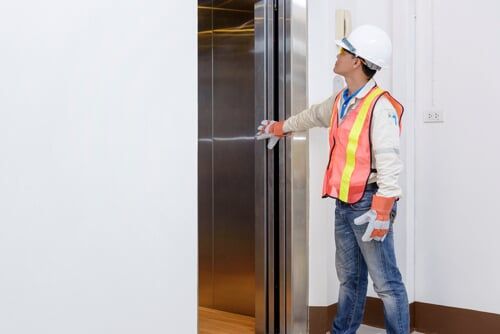Professional Elevator Service, Repair, Testing, and Modernization
Elevator Modernization
IMPROVE YOUR ELEVATOR WITH OUR MODERNIZATION SERVICES IN CHICAGO, IL
Elevator Industries
provides upgrade options to ensure that your elevators operate safely and at peak performance. Elevator upgrades revitalize aging elevator components with current technology, safety standards, and code compliance.
POWER UNITS
Elevator Industries offers power unit replacement to improve consistency and operation for a smooth ride. Pump units provide power to the elevator and enable smooth starting and stopping, as well as leveling to the floor.
SOLID STATE STARTERS FOR REDUCTION IN POWER CONSUMPTION & MAINTENANCE
Solid-state starters apply smooth and steady current to a motor. Old mechanical starters, which have a large influx of current, require more frequent inspections and maintenance.
VALVE UPGRADES FOR PROVIDING IMPROVED RIDE QUALITY & DEPENDABILITY
Defective or worn hydraulic valves cause inconsistent oil flow, leading to abrupt starts and stops, as well as stalling and poor leveling. Applied Elevator installs “Maxton” valves which are specially designed and engineered to replace any valve.
OIL COOLERS
Oil coolers continuously monitor the hydraulic oil temperature. When the temperature reaches a preset limit, the oil is externally circulated through a heat exchanger that cools the oil and returns it to the tank in a hot machine room environment.
TANK HEATERS
Tank heaters maintain consistent hydraulic oil temperatures to prevent rough starts and ensure smooth operation in a cold machine room environment.
BATTERY LOWERING KITS
A battery-lowering unit provides automatic backup power for a hydraulic elevator when the building loses power. The unit returns the elevator to the designated landing and opens the doors, allowing passengers to exit safely.
EMERGENCY ADA PHONE
Emergency push-button phones allow trapped or disabled passengers to call for help. These phones dial preprogrammed phone numbers until a live person is reached.
EMERGENCY LIGHTS
Emergency lights work during a power loss and are designed for use in new construction, modernization, and direct replacements. They meet both lighting and alarm codes per ANSI 17.1.
FIREFIGHTERS' SERVICE (ELEVATOR FIRE SERVICE)
Fire Service returns all elevators to a designated landing and prevents normal operation, and allows only special operation by firefighters or other authorized emergency personnel.
ELECTRONIC SAFETY EDGES
New door safety systems use electronic infrared beams that cover the doorway of the elevator. When the beams are broken, the doors reopen. Unlike old mechanical systems, the new door systems do not come into contact with either passengers or objects to reopen.
JACK PACKING REPLACEMENT
Jack packing is a seal in the jack head which prevents oil from leaking into the elevator pit.
PIT SAFETY EQUIPMENT
The pit safety equipment includes a pit ladder, pit work light, pit stop switch, and a GFCI receptacle to meet codes to reduce the risk of injury, and to provide a safer working environment for all.
SAFETY TEST
Safety tests on all elevators require weights equal to the full weight capacity of the elevator be loaded and the elevator's braking systems checked and evaluated.
SINGLE BOTTOM JACK REPLACEMENT
The jack of a typical hydraulic elevator is installed in the ground beneath the elevator car where it is exposed to the risk of corrosion and electrolysis. These jacks may leak oil, contaminating the environment and endangering passengers.
The ASME A17.1-2000 National Elevator Safety Code has a new provision that requires single-bottom jacks (cylinders) be replaced with double-bottom cylinders or be equipped with code compliant hydraulic safeties.
The ASME A17.1-2000 National Elevator Safety Code has a new provision that requires single-bottom jacks (cylinders) be replaced with double-bottom cylinders or be equipped with code compliant hydraulic safeties.
SHUTOFF VALVE
A shutoff valve manually disconnects the oil flow from the tank to the oil line, both in the machine room and pit, to allow for maintenance.
OVERSPEED VALVES
An overspeed valve stops an elevator car from rapid, uncontrolled descent, thus protecting against oil supply line failure between the jack and the power unit.
SAFETY SIGNAGE
Braille and code signs are required by national codes for use in and around elevators to provide visually impaired passengers with crucial information, such as direction, position, exit, and emergency protocol.
ENHANCING ELEVATOR DOOR PERFORMANCE
DOOR OPERATORS
Eliminate the #1 Cause of Elevator Downtime. Door operators open and close elevator doors, but through use become inefficient, unreliable, or obsolete. A new door operator can improve the safety and performance of the existing elevator operation as well as meet new required safety codes.
FREIGHT DOOR UPGRADES
Manual and/or Automatic Power Operated Freight Doors. Freight door upgrades, which meet or exceed latest codes, reduce the risk of injury or entrapment and the associated liability.
DOOR RESTRICTORS
Door restrictors keep passengers safe by locking the car doors when the elevator car is outside the leveling zone, above and below the floor. This device prevents passengers from attempting to escape from a car that has stopped between landings.

CONTACT INFORMATION
Phone: 773-645-7476
Email: dispatch@elevatorii.com
Address: 3260 W Grand Ave, Chicago, IL 60651
Hours of Operation:
Email: dispatch@elevatorii.com
Address: 3260 W Grand Ave, Chicago, IL 60651
Hours of Operation:
| Mon-Sun | 8:00 AM - 4:30 PM |
| 24/7 Emergency Hotline | |



LOCATION
BROWSE OUR WEBSITE
CONTACT INFORMATION
Phone: 773-645-7476
Email: dispatch@elevatorii.com
Address: 3260 W Grand Ave, Chicago, IL 60651
Hours of Operation:
Email: dispatch@elevatorii.com
Address: 3260 W Grand Ave, Chicago, IL 60651
Hours of Operation:
| Mon-Sun | 8:00 AM - 4:30 PM |
| 24/7 Emergency Hotline | |



LOCATION
Images provided on this website are for personal, non-commercial use. Republication, retransmission, or reproduction of such images is strictly prohibited.

